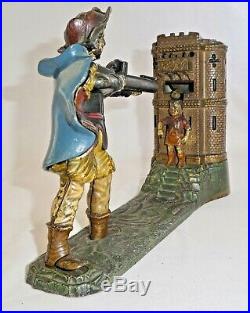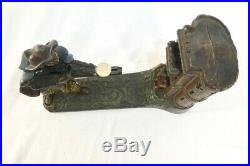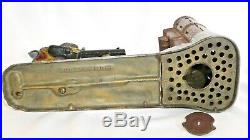J & E Stevens Cast Iron Fully Functional WILLIAM TELL Mechanical Bank Dated 1886













The mechanical bank works well. William Tells head moves; his right foot controls the release of the arrow; when William Tell’s young son wears the apple, the childs arms are by his side. Place a coin on the crossbow, pull back the triangle (the arrow) and press Tells right foot: the coin flies toward the apple the apple disappears, the son raises his right arm in victorious celebration, and the coin is deposited with the Ding! Sound of a bell. On the underside is the original metal coin cover: the round piece easily turns and comes out to release the coins, and just as easily re-inserts and stays closed. Photos 6, 7, and 8 show a dime placed on the crossbow; the dime flying toward to the apple; the child’s right arm up. The cast iron bank demonstrates William Tells expertise with the crossbow (not a rifle as others state). Swiss folk hero William Tells rebellion against the Hapsburg rule led to his capture in 1307. His punishment: To shoot an apple, placed on his young sons head, with a single arrow. If William Tell missed, he and his son would be immediately executed. William Tell, of course, did not miss and the legend of William Tell, founder of Switzerland’s independence, lives on! The Stevens Company, founded in the 1800s in Cromwell, Connecticut, quickly grew famous for its cast iron mechanical banks. Today, as collectors well know, it is rare to find an intact, fully functional authentic Stevens bank. Dimensions : 6.5H x 11W x 4D. Weight : 3.80 lbs. Please send us a message, and we will promptly reply. The item “J & E Stevens Cast Iron Fully Functional WILLIAM TELL Mechanical Bank Dated 1886″ is in sale since Thursday, August 1, 2019. This item is in the category “Collectibles\Banks, Registers & Vending\Mechanical Banks”. The seller is “supermall” and is located in Cincinnati, Ohio. This item can be shipped worldwide.
- Modified Item: No
- Country/Region of Manufacture: United States
- Original/Reproduction: Original
- Brand: J & E Stevens
- Featured Refinements: Cast Iron Mechanical Bank
- City & State of production: Cromwell, Connecticut 1896
